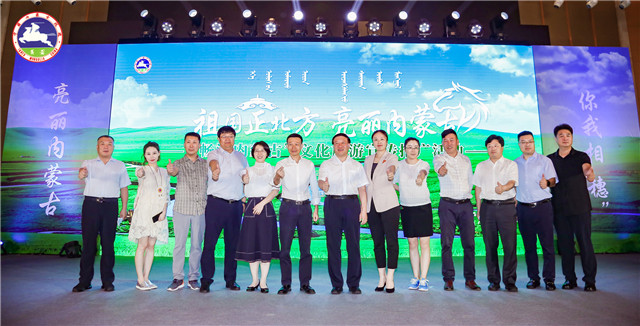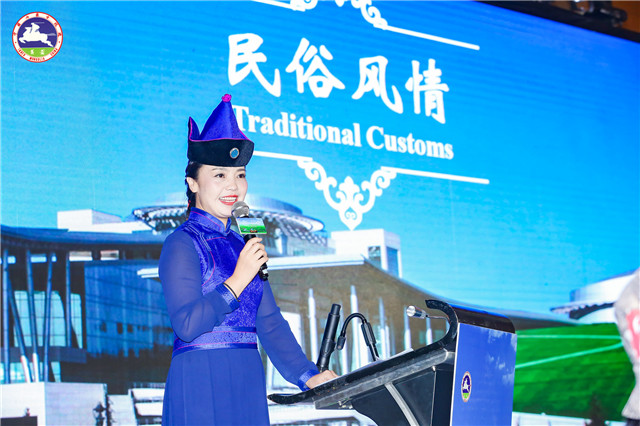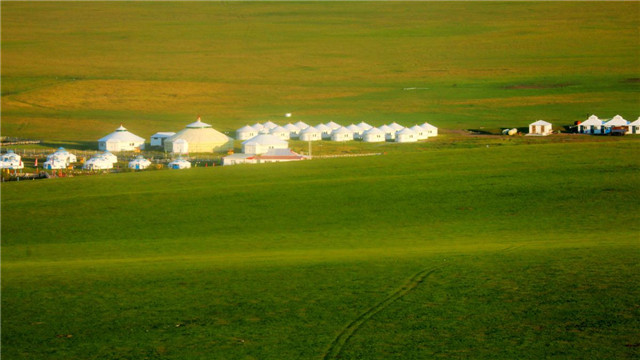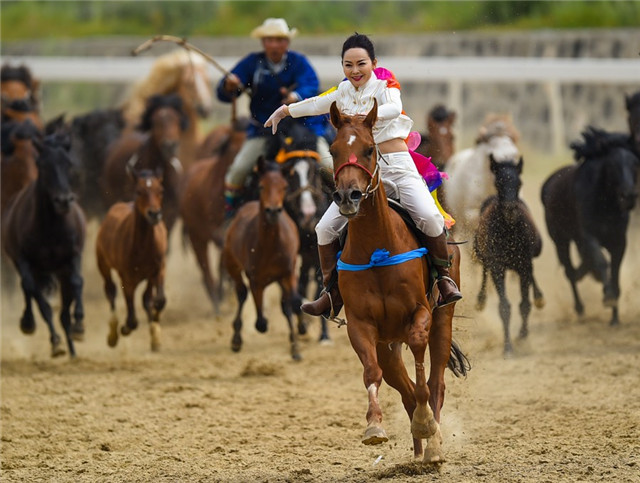Wouldn't it be nice to have a cool trip to the north where you can get away from the heat and enjoy several days of relaxation or celebration during this summer? North China's Inner Mongolia Autonomous Region is extending a warm invitation to all people in Guangdong to visit this magnificent and beautiful place.
Guests from both Inner Mongolia and Guangdong pose for a group photo at the roadshow. (Photo provided to Newsgd.com)
The invitation was extended during a roadshow featuring Inner Mongolia's culture and tourism resources in Guangzhou today (August 14th). Representatives from seven different cities, such as Hohhot and Hulunbuir, promoted the attractions, routes and incentives for tourism in their hometowns to the attendees from Guangdong's travel agencies and media outlets.
The unique dances, traditional Mongolian bowed stringed instrument matouqin, cultural products and local delicacies were also showcased at the roadshow; various kinds of dairy products and handmade 'sunflower sister' dolls, the Ewenki's intangible cultural heritage were on display too.
A representative from Inner Mongolia presents her hometown to the attendees at the roadshow. (Photo provided to Newsgd.com)
Inner Mongolia, the widest and third largest province in China, boasts boundless grassland, plateau, mountains, hills, deserts, rivers and lakes, and has been hailed as having the most attractive summer scenery in the country. The Inner Mongolian Plateau is the cradle of the nomadic culture in North China. Over thousands of years, the ethnic groups living there have created a splendid prairie culture.
According to statistics, 1.15 million people from Inner Mongolia visited Guangdong in 2019, an increase of 25% over the previous year. Last year, 2.38 million people from Guangdong traveled to Inner Mongolia, up 45% over 2018.
The region has now entered its peak tourist season. Here are four self-driving travel routes launched by the region's department of culture and tourism to welcome tourists from all around the world.
The handicrafts of the "Sun Flower" are seen at the Sun Flower Inheritance and Development Center of Ewenki Autonomous Banner, north China's Inner Mongolia Autonomous Region, Aug. 7, 2020. (Xinhua/Xu Qin)
1. Explore vast grasslands and dense forests
Route: Ulaanhot —Arxan—Hailaar—Manzhouli
The travel route spans the Greater Hinggan Mountains and the Hulunbuir Grassland. It offers a variety of cultural activities and tourism landscapes including grasslands, forests, volcanoes, hot springs, rivers, wetlands, lakes and folk customs.
The route is the best self-diving travel route featuring grassland culture and leisure and good tourism facilities in the eastern area of Inner Mongolia.
Photo taken on July 2, 2020 shows the view of a grassland in Xilingol League of north China's Inner Mongolia Autonomous Region. (Xinhua/Jia Lijun)
2. Experience grassland culture
Route: Zhenglan Banner—Xiliinhot—Hexigten Banner—Baarin Right Banner — Chifeng — Harqin Banner
This tourist route crosses Xiliin Gol League and Chifeng city. It passes through the Xiliin Gol Grassland, Hunshandake Sandy Land, Horqin Sandy Land and the southern section of the Greater Hinggan Mountains. It features rich scenery including vast grasslands, wild forests, grand deserts, rivers and lakes, geological wonders and hot springs.
The tourism region neighbors important cities such as Beijing, Chengde, Shenyang and Zhangjiakou and has convenient transportation and location advantages.
Hulunbuir, Inner Mongolia, boasts beautiful summer scenery and comfortable average temperatures. It's an attractive place to escape summer heat. [Photo by Jiang Xiwu/for chinadaily.com.cn]
3. Drive to Inner Mongolia's major cities
Route: Ulaanqab—Hohhot—Baotou—Ordos
There are nine types of tourism activities and resources on this route -- including grasslands, deserts, hot springs, rivers, lakes, folk customs, historic sites, modern industrial and agricultural landscapes and grassland urban features.
Recommended scenic sites along the route include the Genghis Khan Mausoleum, Xiangsha Bay, Qixing Lake, Kangbashi, Zhaojun Museum, Chilechuan Grassland and the Jungar Yellow River Canyon.
Equestrians perform with horses during the opening ceremony of an equine culture event in Xilinhot, north China's Inner Mongolia Autonomous Region, Aug. 1, 2020. (Xinhua/Peng Yuan)
4. Experience desert and Yellow River culture
Route: Wuhai—Alshaa League—Bayannuur
This route takes tourists traveling from Wuhai, crossing the Yellow River and Helan Mountain. On entering Alshaa Left Banner, tourists can visit Yuanying, the Nansi Temple and the Beisi Temple. Moving along the G7 Expressway, tourists can admire the desert and Gobi scenery. While arriving at Ejine Banner, tourists will have the opportunity to see the populus euphratica forests, Juyan Lake, Ceke Port and Dongfeng Aviation City.
Author | Monica
Editor | Jerry
Quick facts about Inner Mongolia Autonomous Region
The Inner Mongolia autonomous region is also called Inner Mongolia for short, with Hohhot as its capital city. Its origin can be traced back to the Ordos people who lived here 2,000 years ago.
With agriculture and stockbreeding as its main livelihood, Inner Mongolia also engages in forestry, coal mining and steel industries. The region boasts abundant natural resources, particularly minerals, and its reserves of rare earth and natural alkali rank first in China.
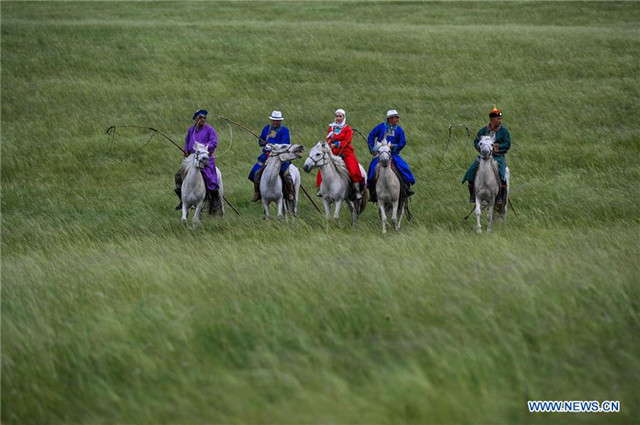
Herdsmen attend a cultural demonstration at a horse-breeding center in West Ujimqin Banner, Xilin Gol League, north China's Inner Mongolia Autonomous Region, July 31, 2020. (Xinhua/Lian Zhen)
Inner Mongolia is a special economic zone renowned as a "treasure basin", with a foremost attraction of natural beauty. Vast grasslands, mushroom-like yurts, bright sky, fresh air, rolling grass and flocks and herds moving like white clouds on the remote grassland, all contribute to relaxing and picturesque scenery.
The Greater Hinggan Mountain, renowned as the "green treasure", is the largest and most preserved primitive forest. As the Kingdom of Wildlife, it is home to over 300 species of birds and 100 species of animals, 40 of which are listed as national rarities.
Inner Mongolia, with a temperate continental monsoon climate, has a cold, long winter with frequent blizzards and a warm, short summer. The mean summer temperature ranges between 20.1℃ and 25.3℃. The difference in temperatures between day and night also varies greatly throughout the year.
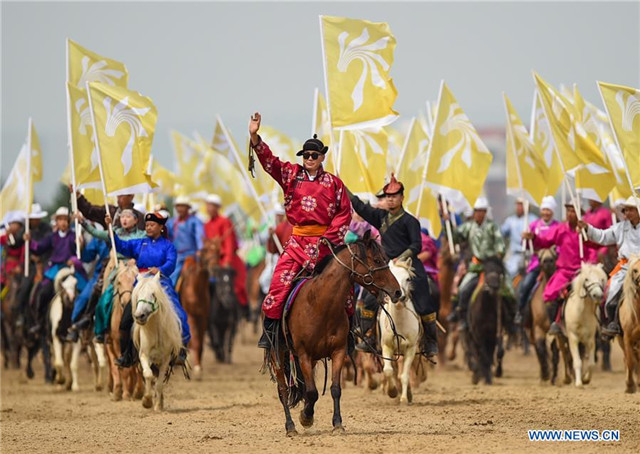
Equestrians perform during the opening ceremony of an equine culture event in Xilinhot, north China's Inner Mongolia Autonomous Region, Aug. 1, 2020. The event kicked off here on Saturday. (Xinhua/Peng Yuan)
Places of interest include Zhaojun Tomb in Hohhot, the Five-towers Temple, the Wudangzhao Monastery, and the Genghis Khan Mausoleum in Ejin Horo Banner. Traditional special local products include pure wool coarse string, Alashan camel's hair, XilinGol mushroom and Hetao melon.
Foods that you can't miss contain roast lamb, instant-boiled mutton, finger mutton and milk tea are some of the staple foods. Singing, dancing and recreational sport are an important part of Mongolian culture.
Source: Official website of the People's Government of Inner Mongolia Autonomous Region




